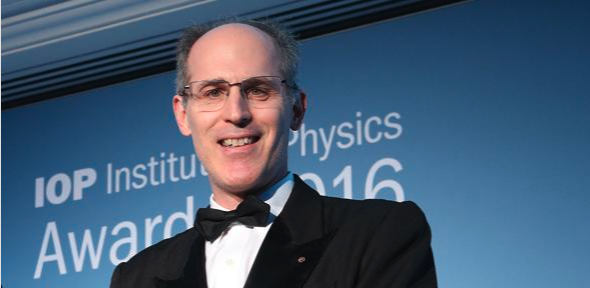
Ray Goldstein, Alan Turing Professor of Complex Physical Systems at the Department of Applied Mathematics and Theoretical Physics (DAMTP), works on an area of Turing's legacy less well-known than the famous mathematician's work in WWII: mathematical biology. In the run-up to the centenary of Turing's death, Goldstein tells us about the work his research group does in Cambridge today, some recent results he's particularly excited about, and how mathematics can help shed light on fascinating problems in evolution.
When we go about our daily lives we don't usually think of the cells that make up our bodies or the atoms that make up the things we see around us. That's because we don't need to: we can understand most of the processes we might be interested in without knowledge of what happens at those tiny scales. There are situations, however, where you need to understand what happens at all scales to make sense of what's going on. When this happens you're dealing with a complex physical system.
We try to understand the physical constraints and principles that led the simplest single-cell organisms that first appeared on Earth to evolve and become larger and more complex. Ray Goldstein
As Turing Professor of Complex Physical Systems, Ray Goldstein knows a lot about such systems. "A complex physical system is one in which there are properties that emerge in a surprising or complex way from the underlying constituents," he says. "A good example would be a suspension of swimming bacteria. If you want to understand the properties of such a suspension, you need to understand everything, from the smallest scales of how those bacteria swim and how they interact with the fluid and each other, all the way up to the scale at which you may do an experiment."
Goldstein and his team work on complex systems that arise in biological physics. "These days most of our work tends to be on problems in developmental biology, looked at from the perspective of physics and mathematics, and using tools from those disciplines," he says. A particular interest are problems that also have an evolutionary aspect to them, involving some of the simplest organisms on Earth. "We try to understand the physical constraints and principles that led the simplest single-cell organisms that first appeared on Earth to evolve and become larger and more complex."
Skin, sponges and algae
The simple organisms Goldstein studies aren't just interesting in their own right, they can shed light on processes that happen within larger animals like ourselves. A group of "workhorse organisms" in this context is a lineage of algae called volvocales. The lineage contains organisms made up of just one cell as well as ones made up of thousands of cells. And because volvocales are easy to grow in the lab they make great objects for study.
A few years ago Goldstein told us about his work on the simplest member of the volvocales family, called Chlamydomonas. The tiny organism swims about with the help of little arms called flagella. Although it doesn't have a central nervous system, Chlamydomonas manages to synchronise the flagella's motion to execute a near-perfect breaststroke. Goldstein's research into how it does this has shed light on surprising feats of synchronisation achieved by hair-like filaments that exist inside our own bodies, for example in fallopian tubes where the synchronised motion helps to move eggs along. You can find out more in this article.
Goldstein's current attention focuses on a multicellular sibling of Chlamydomonas, called Volvox. "Volvox is a spherical organism with about 1000 cells on its surface," he explains. "Because it's mostly transparent and of a convenient size we can image where every single cell is."
The question Goldstein and his team are trying to answer concerns a type of connective tissue that exists in all living organisms, called the extracellular matrix. "This is a protein-containing structure exported from the cells. It gives structural and physiological support to the cells." Our skin contains an extracellular matrix made up of proteins such as collagen. Another example of interest is sponges, among the most primitive animals, whose bodies consist of a network of filter-feeding cells within an extracellular matrix.
The extracellular matrix doesn't itself contain any cells, rather it is produced by them. The question is, how do cells manage to make structures external to themselves in a reliable and robust way? Volvox can deliver answers because its transparent extracellular matrix can be studied using sophisticated imaging techniques. "We can understand the development of this extracellular structure in exquisite detail and try to understand some of the mathematical principles governing the distribution of material that's exported from the cells," says Goldstein. "We're on the cusp of a real breakthrough of understanding this, as a paradigm for the general problem of how cells make external structures."
The wisdom of crowds
While much of Goldstein's research efforts focus on tiny swimmers, he does occasionally study larger animals too. This spring parts of the US will see a momentous event: up to a trillion cicadas are about to simultaneously emerge from their breeding grounds under the Earth. The number of years cicadas spend underground before bursting forth is usually a prime, such as 13 or 17. "This year happens to be an emergence of both a 13 year brood and a 17 year brood," says Goldstein. "The prime numbers arise as an evolutionary strategy to avoid predation. You get out of sync with any possible predator because you can't divide a prime by any other integer except 1."
The question Goldstein and his colleagues considered recently is how the cicadas know to all emerge at the same time in a given year. It was known that temperature is a factor here, but underground temperature varies too much to fully explain the synchronisation. A mathematical model similar to those used to describe magnets and stock market crashes led Goldstein and his colleagues to suggest that communication, probably through underground chirping, also plays a key part. "We discovered that when there's communication, even short-range communication, the individuals in the model can much more accurately come to a group decision and emerge in great numbers"
If the conjecture that communication plays a role is confirmed then this will provide insight, not only into the lives of cicadas, but evolution more widely. "It would provide a striking example of how Darwinian evolution can act for the benefit of the group, not just the individual," Goldstein said in this article.
The world is your oyster
Goldstein's Professorship is named after the British mathematician Alan Turing, famous as a World War II codebreaker and one of the fathers of computer science. The relevance to Goldstein's work comes from another important but less celebrated contribution of Turing's. In his 1952 paper The chemical basis of morphogenesis, Turing considered the process of diffusion, which usually leads to substances mixing up so thoroughly they form a homogeneous whole — think of a drop of ink splashed into water diffusing through the liquid until the colour is the same everywhere.
What Turing showed mathematically, however, is that when the process of diffusion coexists with chemical reactions in a particular way, then the end result can be a startling pattern, such as the one you can see on the seashell Goldstein shows in the video below. "The idea that such patterns could arise purely from physical means, a combination of diffusion and chemistry, was totally new when Turing proposed it. We now understand that it underlies a tremendous amount of phenomena in biology and physics."
Like Turing's work, Goldstein's research relies heavily on mathematical theory. But unlike most mathematicians, Goldstein also uses experiments. DAMTP is a great place to conduct this kind of work because, unusually for a maths department, it provides laboratory space where scientists can study organisms such as Volvox. "We have an incredibly good experimental lab with a lot of infrastructure and support from the Department and the University," he says.
Beyond the lab Goldstein describes DAMTP as a perfect research environment. "It's a very broad department in terms of the subjects represented — everything from string theory and cosmology, to what I do, to image processing and artificial intelligence in healthcare," he says. Expertise in so many different fields also allows for the interdisciplinary approaches that often yield exciting progress in problems that cut across boundaries.
"All of this comes with an ethos of 'if it's interesting just do it'," says Goldstein. "So the world is your oyster."

